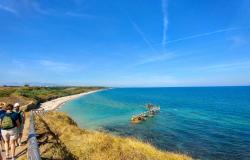Yesterday was a solemn Easter Monday in L’Aquila [Abruzzo] as preparations were made for the night-time commemoration of the earthquake which struck the town and surrounding area at exactly 3.32 am on 6th April last year. 308 people died, more than 1,600 were injured and up to 65,000 were made homeless.
Italy, during the days following the tragedy, united to help the victims as, indeed, did people all over the world. Much was achieved but much more, say the survivors, remains to be done.
Some survivors genuinely feel that their town will become a sort of “Pompeii” for, while certain historically important buildings will be restored, there is no comprehensive plan to restore other buildings in the city and water, gas and electricity are still not functioning in the city centre.
The weeks leading up to the first anniversary of the quake have seen exasperated citizens commandeering wheelbarrows and clearing away some of the 100 million cubic feet of remaining rubble themselves. Mindful that citizens had already been angered by allegations of corruption in the allocation of building contracts for the G8 Summit in the town in July, the authorities eventually relented and allowed them in to the city centre “red zone”, which is still deemed to be dangerous.
Mr Berlusconi’s government received some credit for rehousing, before the winter, around 17,000 victims who had been living in tents since the quake. However, there have been protests about the criteria used to allocate the new homes and spokesmen for survivors’ groups say that the new housing estates are being built too far away from L’Aquila itself. It would be more cost effective, they say, to concentrate on rebuilding the city and allow people to return to their original homes or be rehoused within it. It is estimated that some 50,000 people are still waiting to be allowed home or rehoused. Many are living in tents, hotels or barracks.
All this is to be documented in a film by Sabina Guzzanti [“Viva Zapatero”] called “Draquila – L’Italia che trema” [“Draquila – Italy Shaking”] which is to be released on 7th May. It is expected to be very controversial indeed.
The commemoration ceremonies themselves have not been without controversy so far, with a letter from Mr Berlusconi being booed during the Extraordinary Meeting of the Town Council which inaugurated them on Monday. A message from President Napolitano, however, received applause. The President acknowledged the suffering of the survivors and bereaved and expressed the hope that
“the spirit of social and institutional solidarity shown in the days following the quake will serve as an example of the way in which Italy should face the national and international economic challenges of this difficult time”.
Torchlit processions were held in L’Aquila throughout Monday – Tuesday night and at 3 am the names of the dead were read out. A Mass followed at 4 am. On Tuesday a crown will be placed in the City’s main square in memory of those who lost their lives. There will be photography exhibitions, Masses and concerts throughout the day.
At 10.30 am a sit-in will be held at the Villa Comunale dell’Aquila, where the organisers will collect signatures for a petition calling for the repair and rebuilding of houses in the city. This petition will be presented to Parliament. At 3pm adults and children will form a “human crown” and white balloons will be released to symbolise not only the victims but also “all the elderly people from L’Aquila who lost their possessions and died far from their homes.”





